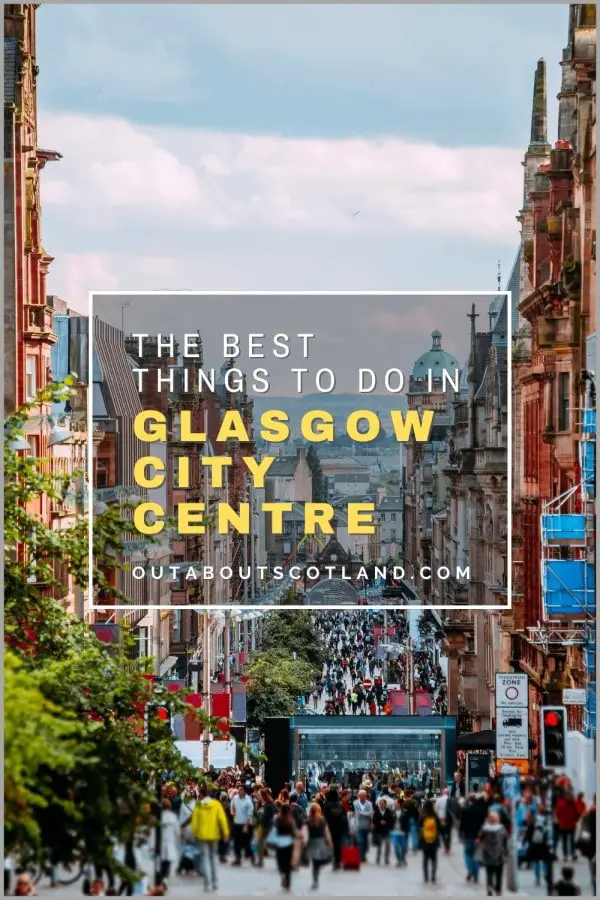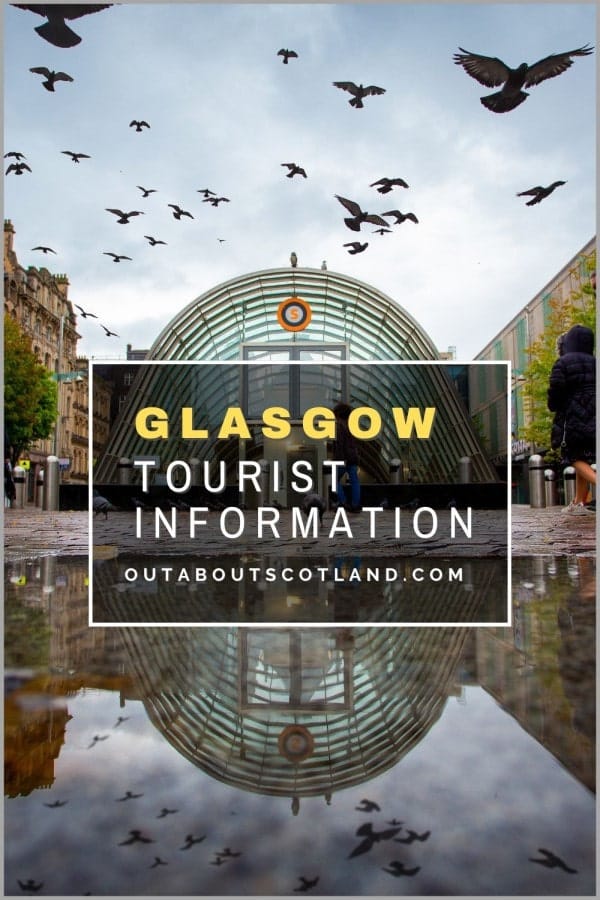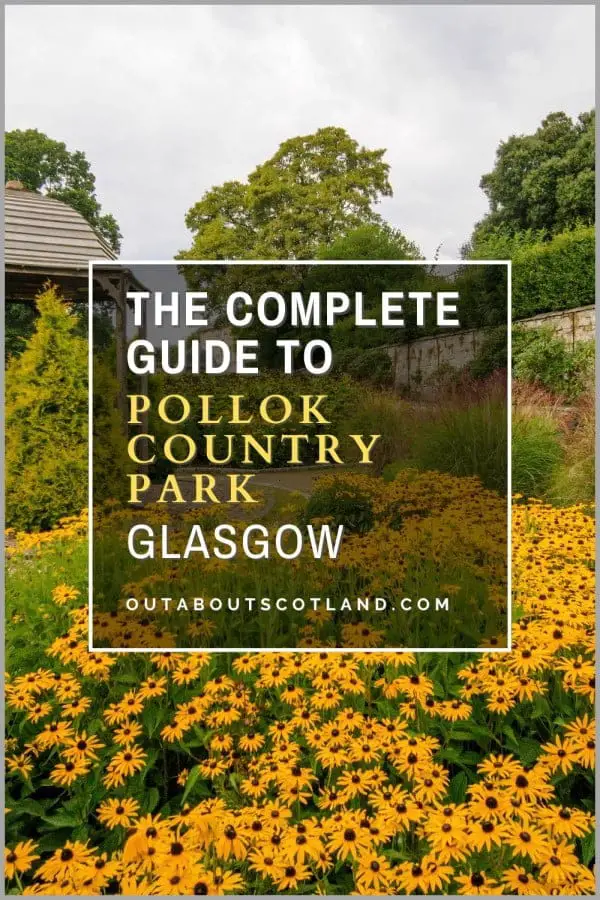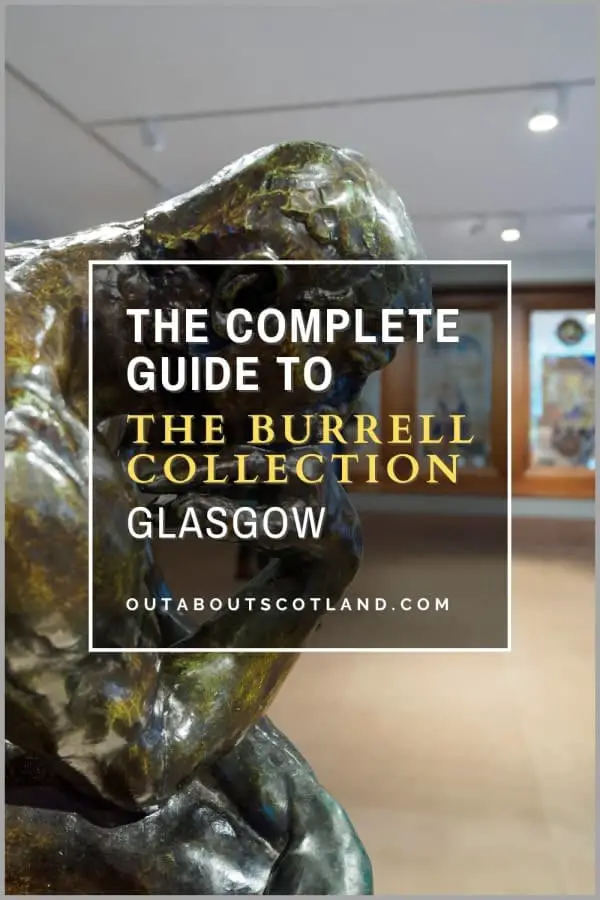Glasgow – a city that seamlessly blends the old and the new, where historic architecture meets modern design and where a vibrant cultural scene thrives amidst a backdrop of superb dining experiences. In this article, we’ll dive into the heart of Scotland’s largest city to explore its iconic landmarks, sample its gastronomic delights, and immerse ourselves in its lively music and arts scene. Whether you’re a history buff, a foodie, an art lover, or simply a curious traveller, Glasgow is an absolute must-visit for any weekend adventurer.
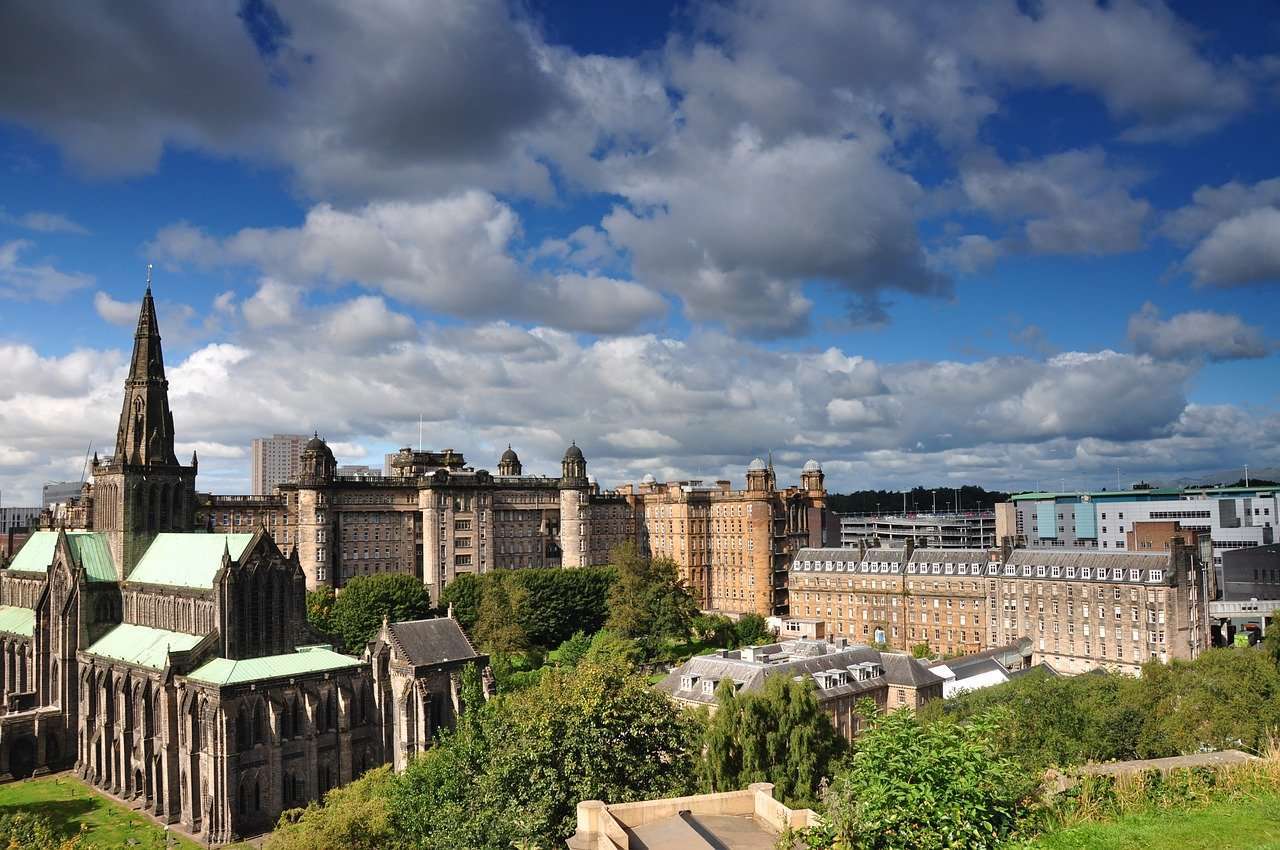
Attractions to Visit on a Weekend Break in Glasgow
Glasgow is the largest city in Scotland both in size and population, with around 600,000 people living in this cosmopolitan city situated on the banks of the River Clyde. Once famous for its shipbuilding industry, the city is now more famous for its bustling shopping areas and world-class theatres, museums and galleries.
Second only to Edinburgh for the amount of green space per acre, Glasgow also boasts some of the finest parklands of any city in Britain and a wide range of traditional and modern music events can usually be found playing somewhere in the city.
The heart of Glasgow is the River Clyde which is where the first rural settlements began in pre-Roman times with the river eventually proving to be an ideal location for Roman outposts. The city was officially founded 600 years later by St. Mungo with the establishment of a church at the site where Glasgow Cathedral now stands, and with each passing century, the population expanded until the city became one of the great industrial areas and sea ports of Great Britain.
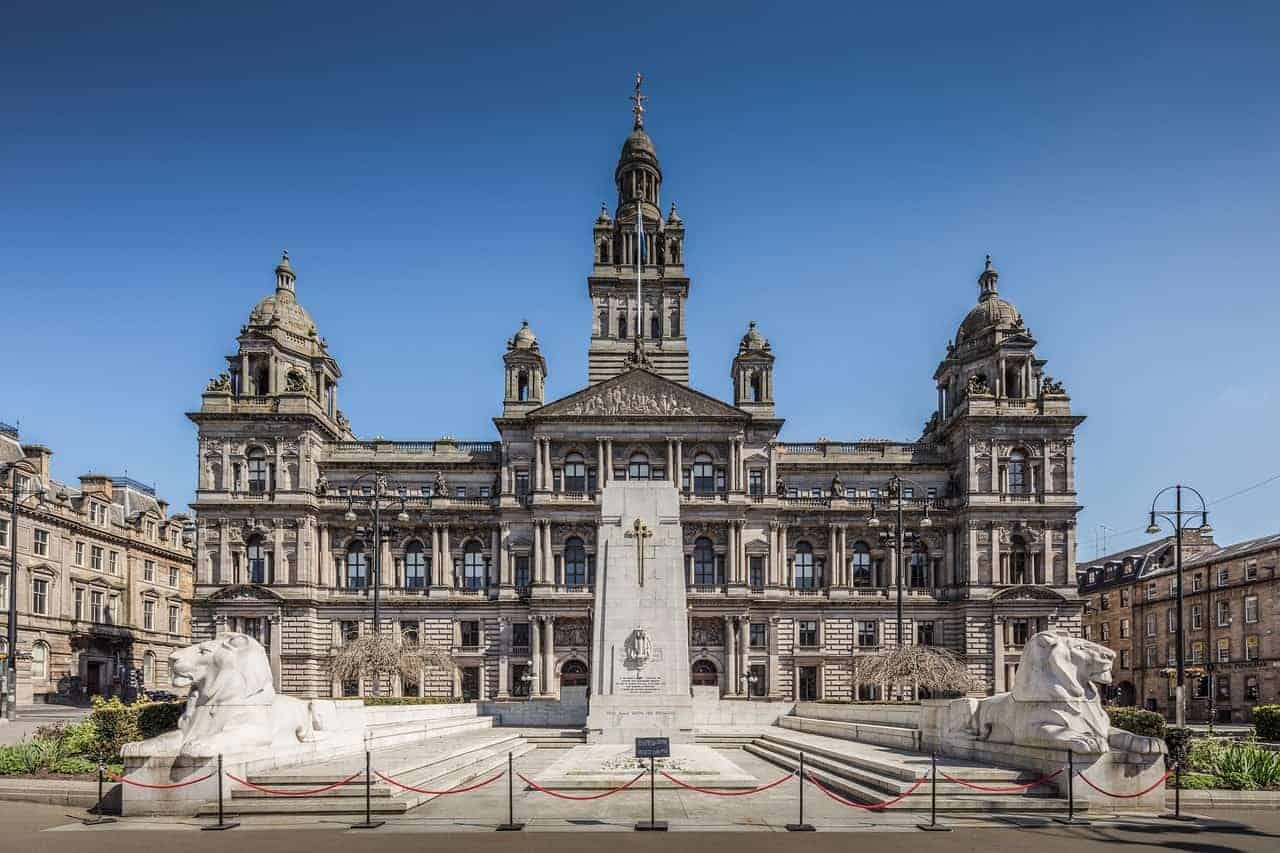
Medieval buildings and architecture can still be seen in many districts such as the Trongate and Saltmarket, and some of Glasgow’s best Gothic architecture and sculptures can be seen at the 37-acre Victorian Necropolis.
Nearby you’ll find the 18th-century Merchant City which was once an important trading place for shipping to the Americas and the Caribbean, while the River Clyde plays host to a number of museums celebrating Glasgow’s rich cultural heritage including the Riverside Transport Museum and the Glenlee, otherwise known as the Tall Ship. There are also some of the finest museums in Scotland including Kelvingrove Art Gallery and Museum and The Hunterian Museum, while Glasgow’s proud heritage is celebrated in the wonderful People’s Palace.
All of these sites are easily visited thanks to a network of buses and the third-oldest underground transport system in the world, and train connections mean Edinburgh is just one hour away.
While you could walk around Glasgow on foot and hope to find all of the following attractions by yourself, it’s perhaps a better idea to book a ticket on a tour bus which circles around the main tourist destinations throughout the day. Simply get off at one stop, visit the attraction, and then hop back on the bus the next time it comes around to head to the next place on your itinerary. Hop-on hop-off buses will save you time and a lot of headaches, and the prices for an all-day ticket are very reasonable for the convenience they offer.
Protect Your Family From Scotland's Biting Midges
- Powerful, reliable protection for up to 8 hours
- Water- and sweat resistant
- Repels midges, mosquitoes, horse flies, sand flies, fleas and ticks
- Safe for use on adults, children over 30 months and pregnant women
- Non-sticky, moisturising with a pleasant fragrance
- Packaging may vary
A Weekend Break in Glasgow – Day One
- The Riverside Museum
- Kelvingrove Art Gallery
- Gallery of Modern Art
Kelvingrove Art Gallery and Museum
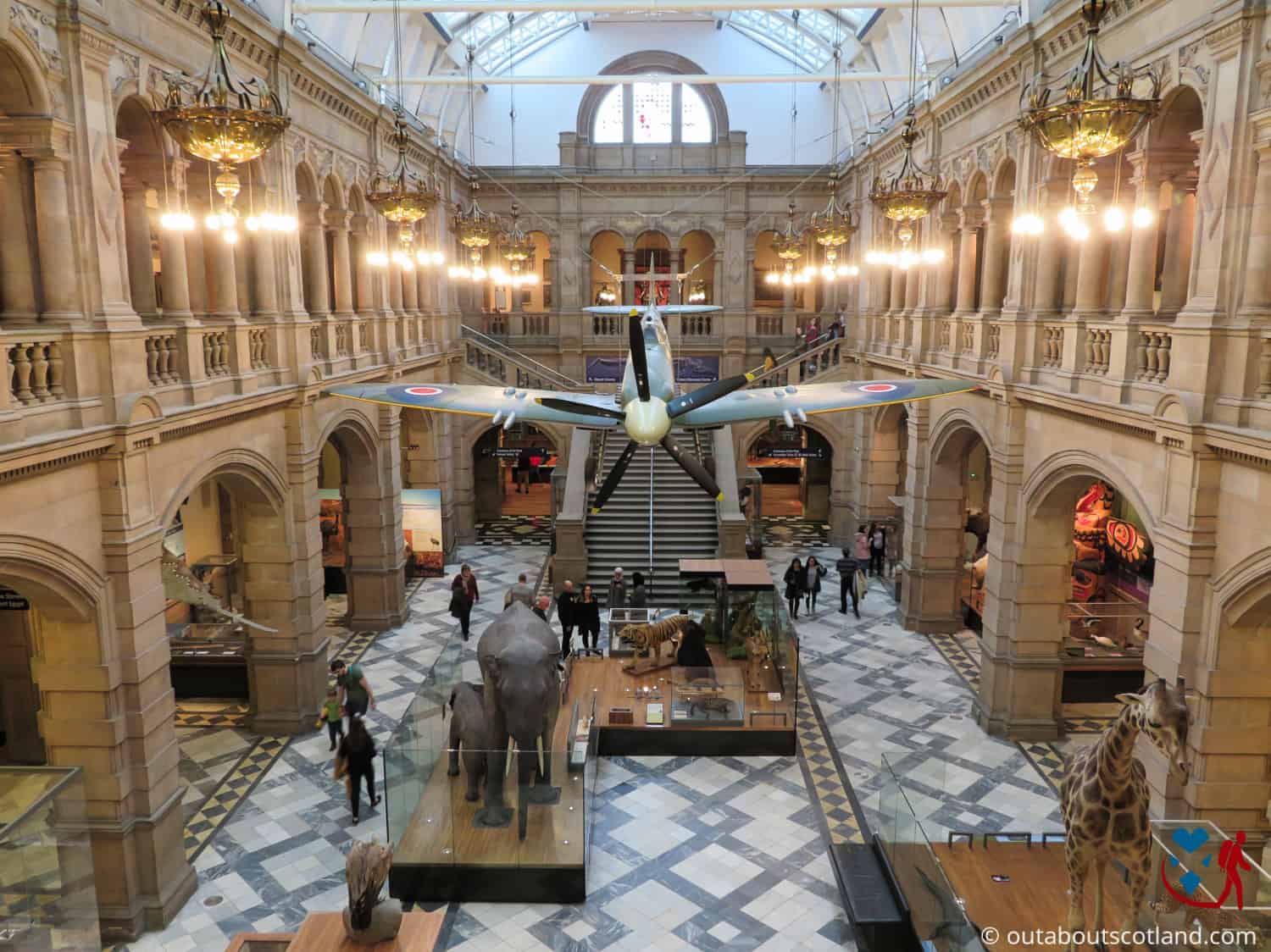
This stunning building has been entrancing visitors for over 115 years and from the very first moment that people step onto the marble floor of the central hall they’re captivated by the diversity of the exhibits on display. Inside the museum are over 9,000 artefacts and paintings that depict every aspect of the city from wildlife, war, art and literature, to Glasgow’s industrial past.
As part of a major restoration project the museum was extensively renovated over three years and was re-opened in 2006 with the exhibits organized into two halves; Life and Expression. The Life galleries represent natural history, human history and prehistory while the Expression galleries include fine art collections.
Both themes are staged across 22 state-of-the-art galleries that are large enough to easily take up several hours of your day.
Kelvingrove is second only to the museums of London for the number of visitors it draws annually, with many coming to view the great art collection which is arguably one of the best in Europe. In it, you’ll find masterpieces from Rembrandt, Renoir, Salvador Dalí and others alongside antiquities from Ancient Egypt and more modern works from the celebrated Glasgow designer Charles Rennie Mackintosh.
All in all, Kelvingrove Art Gallery and Museum is a must-see attraction during your time in Glasgow. If you want to learn more about this attraction you can read my Complete Guide to Kelvingrove Art Gallery and Museum which will tell you everything you need to know before you visit.
- Opening Times: Mon to Sun 10:00 (11:00 Sun) to 17:00
- Entry Prices: Free entry
- Address: Argyle St, Glasgow, G3 8AG
- Telephone: +44 (141) 276 9599
- email: museums@glasgowlife.org.uk
Book Tours in Scotland
The Gallery of Modern Art
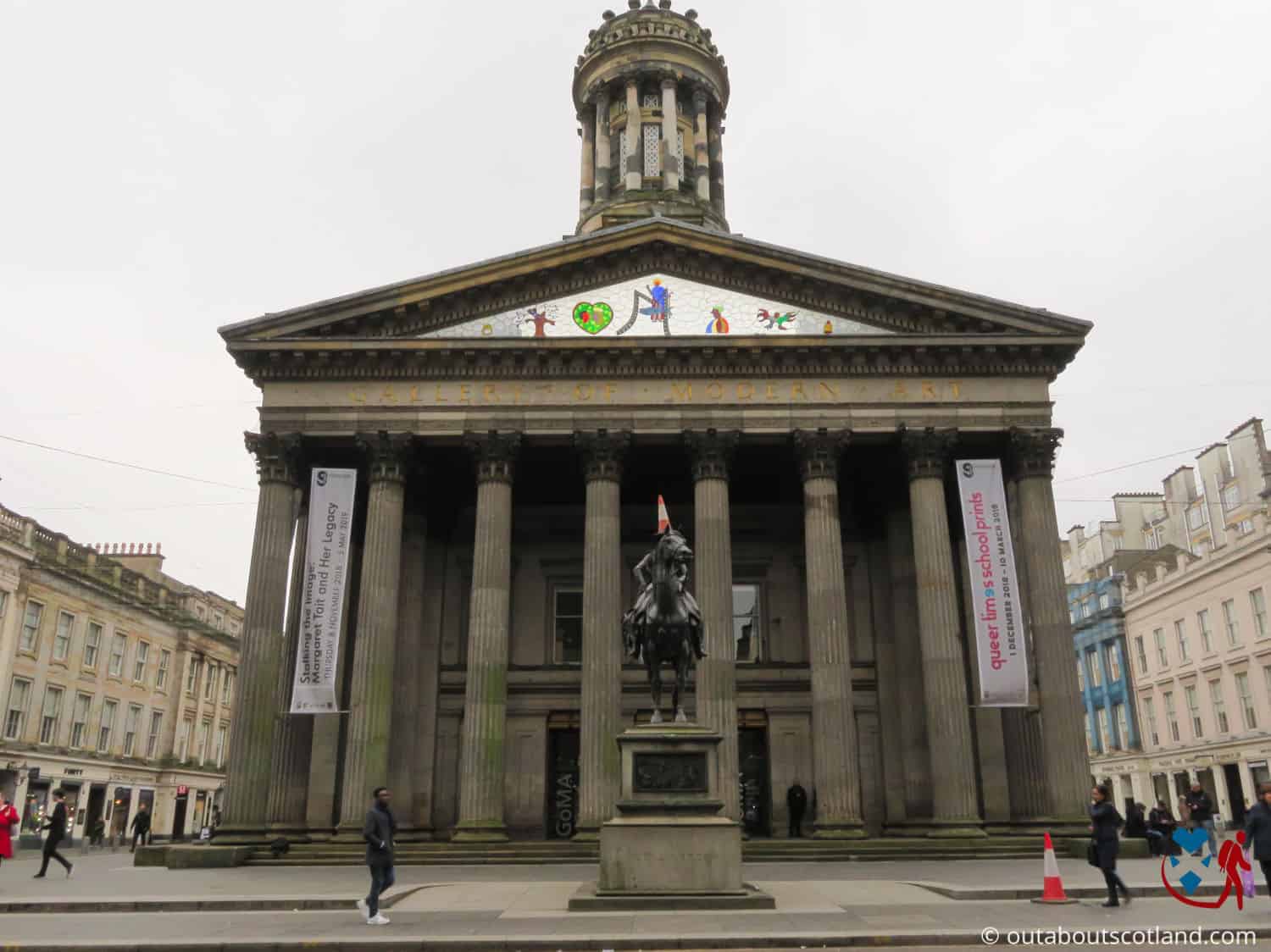
The Gallery of Modern Art is the main gallery of contemporary art in the city and it’s one of the most-visited attractions in Glasgow city centre.
This impressive neoclassical building was built in 1778 as the townhouse of a wealthy Glasgow trader but was subsequently used by the Royal Bank of Scotland before being converted into the Royal Exchange. Glasgow District Libraries took over the building in 1954 and it continued life as a library until 1996 when its usage was converted yet again, this time to house the city’s modern art collection.
The gallery receives several million visitors annually and serves to both educate and entertain tourists and locals alike with workshops, artist receptions and a learning library in the basement. The exhibits are some of the finest in Britain and are the equal of any modern art gallery in the world, with pieces by David Hockney and Andy Warhol displayed alongside works by up-and-coming local talent.
Tired feet can take a rest at the café while the multimedia terminals will be of use to anyone wanting to learn more about modern art.
Of particular note is the front of the gallery which is the home of the Duke of Wellington statue, made famous for the traffic cone that has been perched on his head for several years. Clearly a sign of the well-known Glaswegian sense of humour, the cone has been removed several times by local authorities but has been replaced each time by locals so it’s now a permanent fixture on the statue.
I’ve created a Guide to the Glasgow Gallery of Modern Art that goes into greater detail.
- Opening Times: Mon to Sun 10:00 (11:00 Sun) to 17:00
- Entry Prices: Free entry
- Address: Royal Exchange Square, Glasgow, G1 3AH
- Telephone: 0141 287 3050
- email: museums@glasgowlife.org.uk
The Riverside Museum
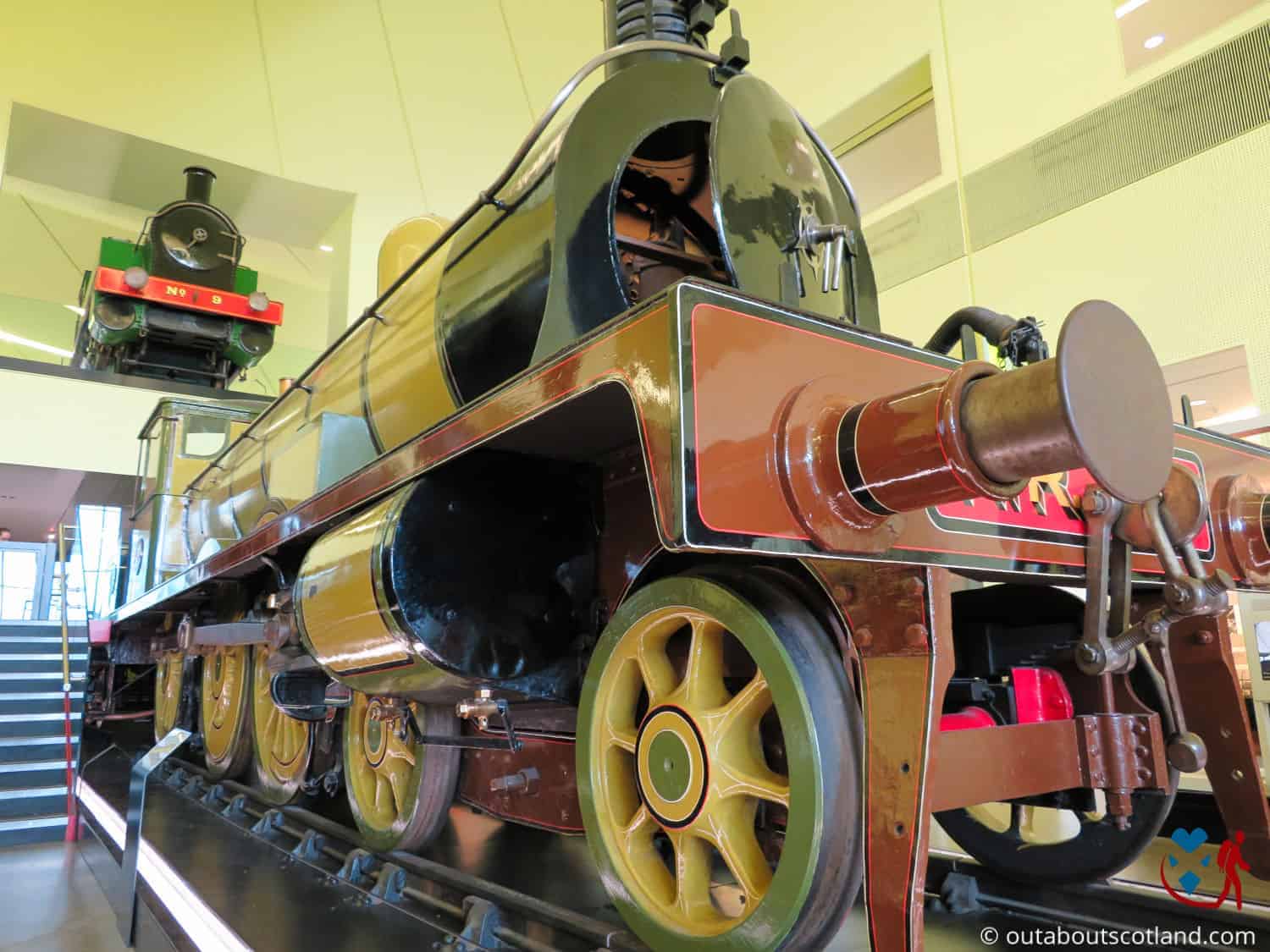
The Glasgow Museum of Transport is one of the most popular tourist venues in the city, with over a million visitors pouring through its doors each year.
The location of the Transport Museum on the north bank of the River Clyde is not accidental, as this is the site where the old A & J Inglis shipyard stood for over 100 years until its closure in 1962. The shipyard made over 500 ships during its lifetime and the Transport Museum goes some way to preserving Glasgow’s shipbuilding heritage with the Clyde Maritime Trust’s SV Glenlee permanently moored alongside the museum.
Inside the building, you’ll find an impressive range of transport memorabilia with full-size steam locomotives exhibited alongside buses, trams, cars and bikes. In total, there are more than 3,000 objects on display from Glasgow’s industrial past.
Perhaps the most impressive display is the faithful recreation of an entire cobbled Glasgow street with shops dating from 1895 all the way through to the 1980s. And best of all, like the majority of museums in Glasgow, the Transport Museum is completely free to visit.
You can discover this museum in greater detail with my Complete Guide to The Glasgow Riverside Museum.
- Opening Times: Mon to Sun 10:00 (11:00 Sun) to 17:00
- Entry Prices: Free entry
- Address: 100 Pointhouse Place, Glasgow, G3 8RS
- Telephone: 0141 287 2720
- email: museums@glasgowlife.org.uk
Protect Your Family From Scotland's Biting Midges
- Powerful, reliable protection for up to 8 hours
- Water- and sweat resistant
- Repels midges, mosquitoes, horse flies, sand flies, fleas and ticks
- Safe for use on adults, children over 30 months and pregnant women
- Non-sticky, moisturising with a pleasant fragrance
- Packaging may vary
A Weekend Break in Glasgow – Day Two
- Glasgow Botanic Garden
- Glasgow Necropolis
- House For an Art Lover
Glasgow Botanic Gardens
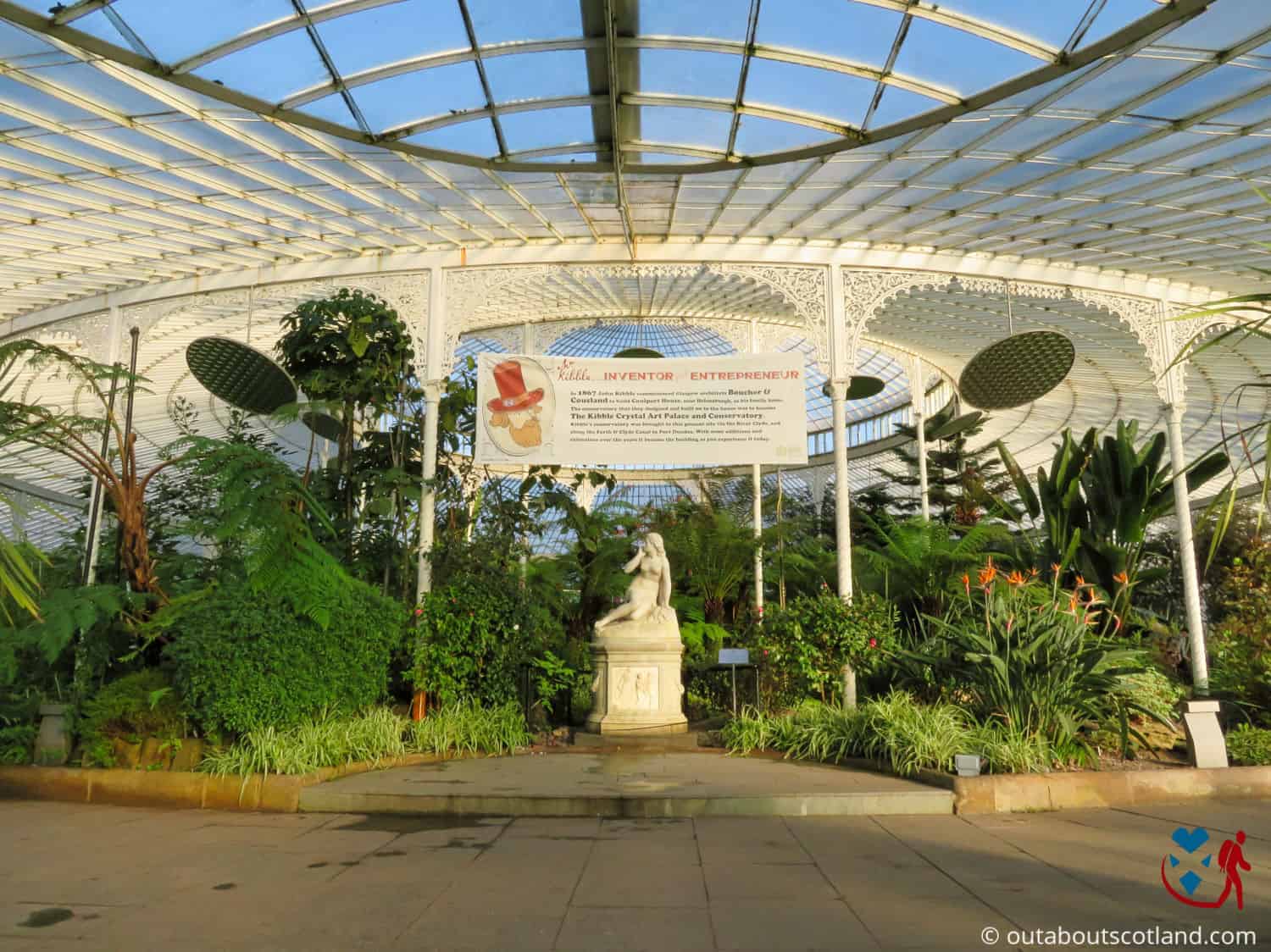
No visit to Glasgow can be complete without a visit to the ever-popular Botanic Gardens in the city’s west end. This peaceful oasis of plant life is the perfect antidote to the hectic buzz of the city centre and it’s a place where you’ll not only find an astounding variety of plants but also quiet woodland copses and relaxing walks along the River Kelvin.
The grounds also feature several giant glasshouses that will transport you from the cool climate of West Scotland to the balmy heat of tropical rainforests. The grounds of the Botanics have been a popular leisure site in Glasgow for over a hundred and seventy years and the land on which they now sit was once used as a major venue for concerts.
The biggest addition to the modern Botanics was made in 1873 when the largest greenhouse on the site, the ‘Kibble Palace’, was moved from its previous home at Coulport on Loch Long to its current location. This impressive 2,137 square-metre greenhouse houses the national collection of tree ferns as well as exotic specimens from tropical rainforests across the globe.
The wrought iron and glass Victorian glasshouses feature enough plants to keep visitors entertained for a good few hours and the collections of orchids, carnivorous plants and tree ferns serve as an interesting alternative attraction to the industrial-themed venues that the rest of the city is famous for.
Discover this fantastic city attraction in greater detail with my Complete Guide to Glasgow Botanic Gardens.
- Opening Times: Grounds: 7 am – dusk (all year), Glasshouses: 10 am – 6 pm (all year except winter), 10 am – 4.15 pm (winter), Winter Oct-Mar. Summer Apr-Sep.
- Entry Prices: Entry to the gardens is free.
- Address: 730 Great Western Rd, Glasgow, G12 0UE
- Telephone: 0141 276 1614
Book Tours in Scotland
The Necropolis
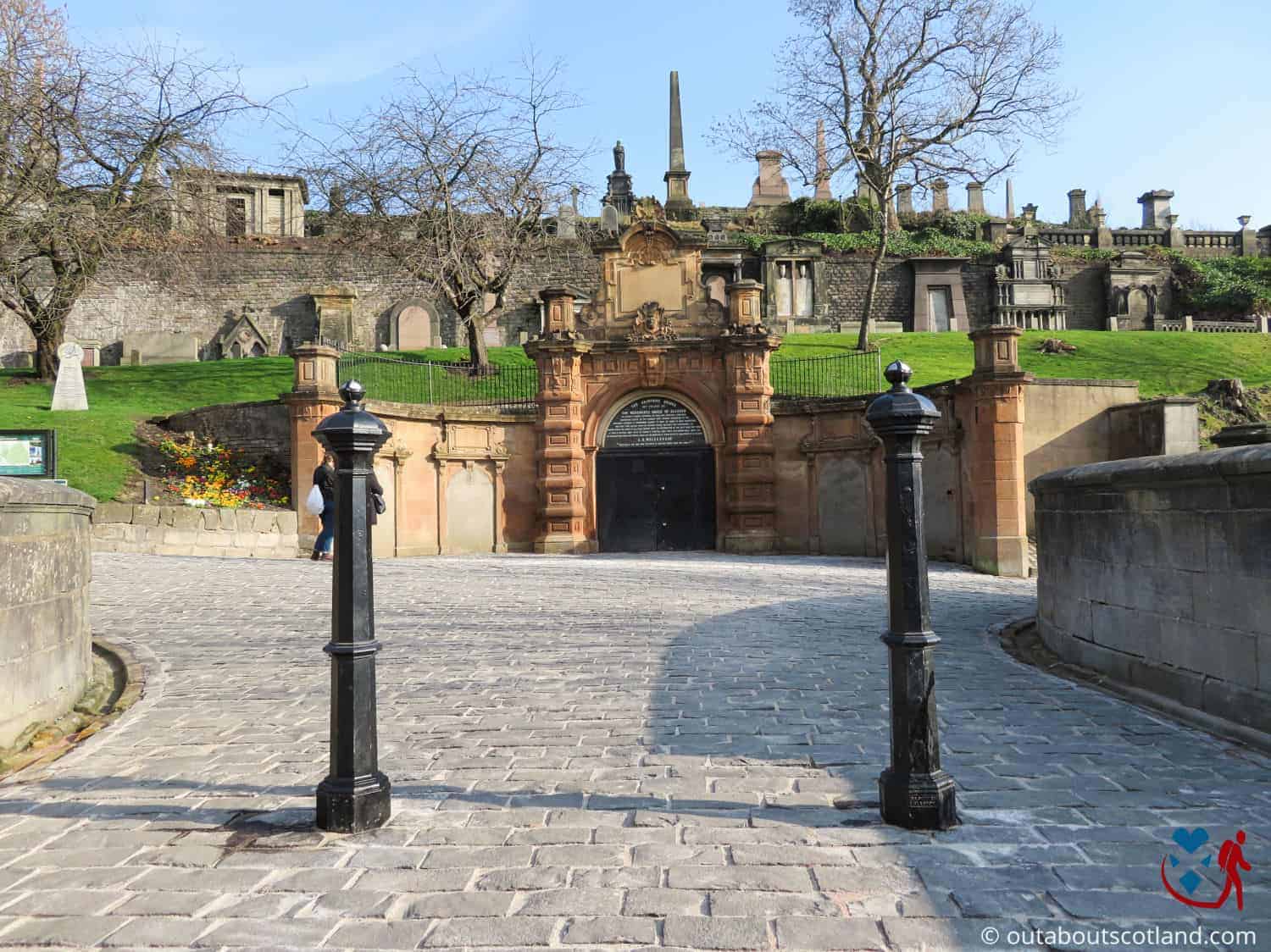
This Victorian cemetery located on a hillside to the east of Glasgow Cathedral is the final resting place of over 50,000 people, of which 3,500 are buried under a collection of ornate monuments and gravestones. The graveyard officially opened in 1832 although there were other monuments there before this date, most notably that of the 16th-century Scottish reformer John Knox.
A walk through The Necropolis will reveal many monuments to Scotland’s most prominent historical figures including Charles Rennie Mackintosh (actually buried in London), and William Miller, the man responsible for the children’s nursery rhyme Wee Willie Winkie. As more and more Glasgow residents were buried at the Necropolis several extensions had to be added in the late 19th century, and today the entire site covers a remarkable 37 acres.
A network of paths meanders all the way through the graveyard which provides an interesting walk through Glasgow’s history that’s quite unlike any other in the city.
One of the reasons that this graveyard has become so popular as a tourist attraction is that there are so many different faiths interred there, with Catholics, Protestants, Quakers, and Jews laid to rest under some of the most beautiful sculptures to be found in any graveyard in Britain. If you want to learn more about The Necropolis I’ve put together a Complete Guide to The Glasgow Necropolis that will tell you all about its history and even take you on a 360-degree virtual tour.
- Opening Times: Open from 7.00 am till 4:30 pm daily.
- Entry Prices: Entry to The Necropolis is free.
- Address: Castle St, Glasgow, G4 0UZ
- Telephone: NA
- email: tours@glasgownecropolis.org
House for an Art Lover
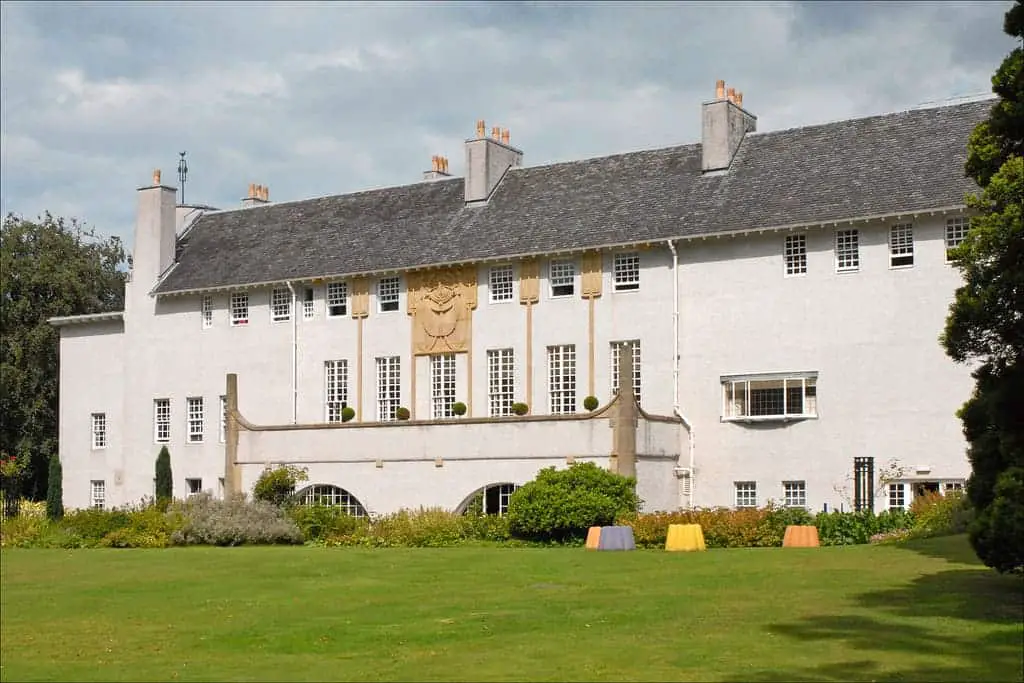
The House for an Art Lover is based on a 1901 design by Charles Rennie Mackintosh, although it was actually constructed between 1989 and 1996. Situated on land in Bellahouston Park in central Glasgow, the building is a focal point for displaying art exhibitions by some of Glasgow’s leading talent as well as encouraging an interest in art, design and architecture.
In addition to the galleries, there are regular workshops and artist conferences held at the House for an Art Lover while a café and souvenir shops cater to tourists.
Bellahouston is one of Glasgow’s oldest and finest public parks which became famous nationwide for hosting the 1938 British Empire Exhibition that was visited by over 12.5 million people. Today, the 169-acre site is mainly used as a recreational area for walks and summer picnics, with the House for an Art Lover taking pride of place in the centre.
Visitors to the site can wander around a Victorian walled garden in the house’s studio pavilion while the Art Park includes an educational Glasgow heritage centre built inside a former stable and dovecote. There’s also an exhibition dedicated to one of the city’s most famous residents (and designer of the building) Charles Rennie Mackintosh.
- Opening Times: Both the Art Lover’s Café and the Art Lover’s Shop are open daily from 10 am to 5 pm. The Mackintosh Exhibition opening times vary so contact the venue for details. The Heritage Centre is open daily from 10 am to 4 pm.
- Entry Prices: See the website
- Address: Bellahouston Park, 10 Dumbreck Rd, Glasgow, G41 5BW
- Telephone: 0141 353 4770
- email: info@houseforanartlover.co.uk
Protect Your Family From Scotland's Biting Midges
- Powerful, reliable protection for up to 8 hours
- Water- and sweat resistant
- Repels midges, mosquitoes, horse flies, sand flies, fleas and ticks
- Safe for use on adults, children over 30 months and pregnant women
- Non-sticky, moisturising with a pleasant fragrance
- Packaging may vary
Bonus Attraction – The Glasgow Science Centre
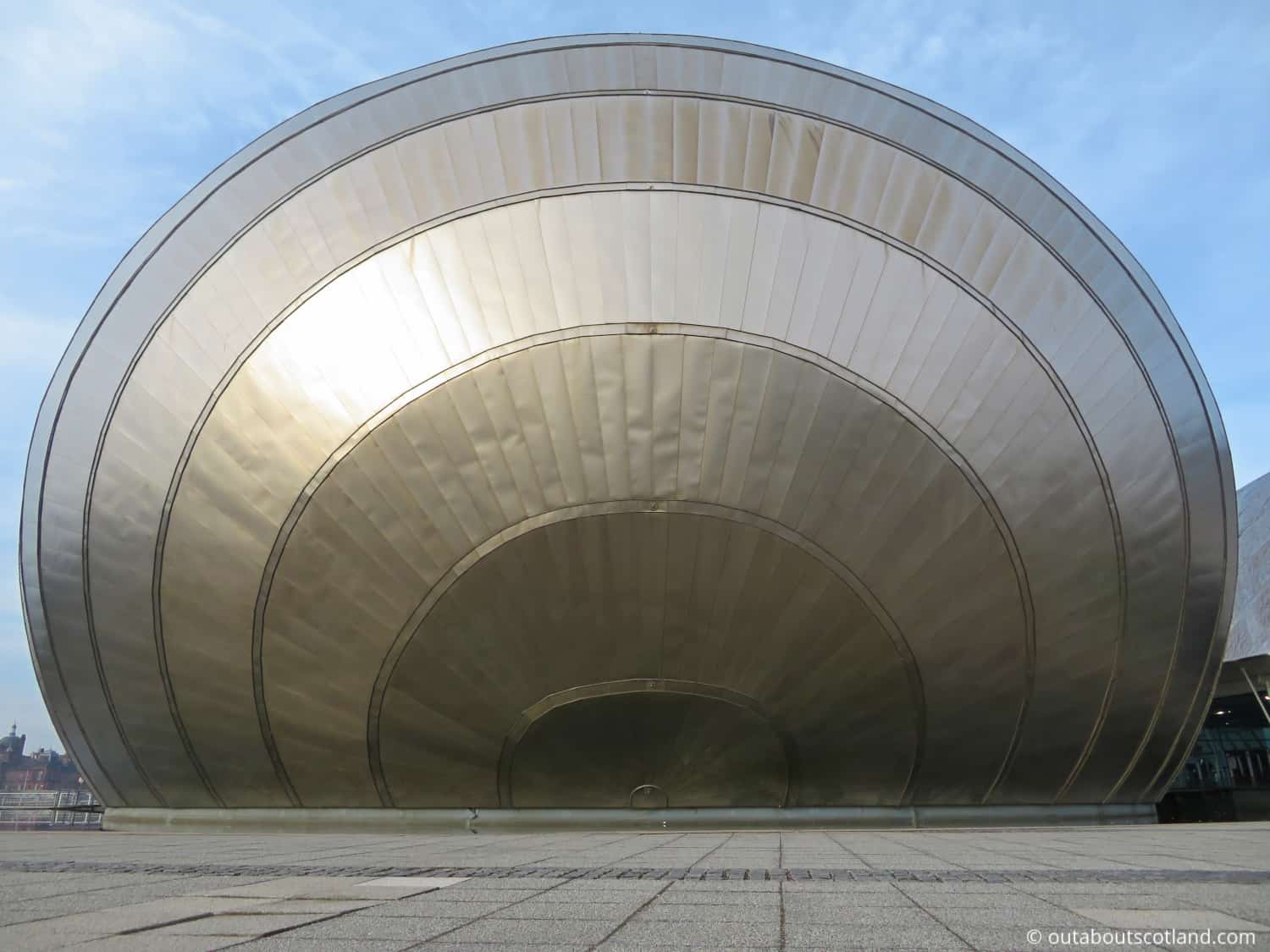
The Glasgow Science Centre is split into three sections and you can purchase tickets for each separately or save a wee bit of money and buy all-in-one tickets, including a ‘Science Passport’ which allows free re-admittance for the following 12 months.
The most impressive section is the enormous Glasgow Tower, officially the tallest fully rotating structure in the world. There’s a lift that takes visitors to the very top where you can view the city from a viewing platform that offers a full 360° panorama and having been up there twice I have to say the view is nothing short of breathtaking.
The next section features a bizarre-looking bowl-shaped building which is, in fact, the IMAX planetarium. You don’t have to be a child to be enthralled by the immersive shows that are played out on state-of-the-art screens, but they’re generally aimed at visiting schools so each show has an element of education to it. If you have children with you, I guarantee they’ll love it.
The final section is the science mall which is where all the interactive exhibits are located. This is the most child-themed part of the attraction as it’s filled to the rafters with things to prod and poke that demonstrate science in all its forms, from forces and energy to optical illusions.
There are enough activities at this attraction to keep visitors occupied for the majority of the day so it’s just as well there’s an on-site café to keep hungry bellies filled, and if the kids are complaining they don’t want to leave at the end of the day you can always bribe them with something from the gift shop.
- Entry Prices: See the website
- Address: 50 Pacific Quay, Glasgow, G51 1EA
- Contact details: Tel 0141 420 5000
- Out About Scotland complete guide: The Glasgow Science Centre
Flights to Glasgow

Glasgow Airport is an international travel hub with around 30 airlines serving over 120 destinations worldwide, including Canada, the US, the Caribbean, Europe and the Gulf. Glasgow is Scotland’s principal long-haul airport as well as Scotland’s largest charter hub. Carrying over nine million passengers each year, Glasgow Airport serves more Scottish destinations than any other airport and is a key component of Scotland’s transport infrastructure.
There are regular bus links from the city centre to the airport as well as dedicated taxi ranks at the airport entrance and exit. If you’re taking the bus then the First Glasgow Airport Express service 500 connects you directly to the airport from Queen Street in Glasgow City Centre and Glasgow Central Train Station.
When driving your own car, exit the M8 at Junction 28 if you are travelling from the east, or Junction 29 if you’re travelling from the west. The airport has a dedicated drop-off/pick-up facility located opposite the main check-in hall.
If you want to take a train to the airport from the city centre, the nearest station is Paisley Gilmour Street – just over one mile from the terminal. From there you can take McGill’s 757 bus service to the airport departure building.
Book Tours in Scotland
Train Travel in Glasgow
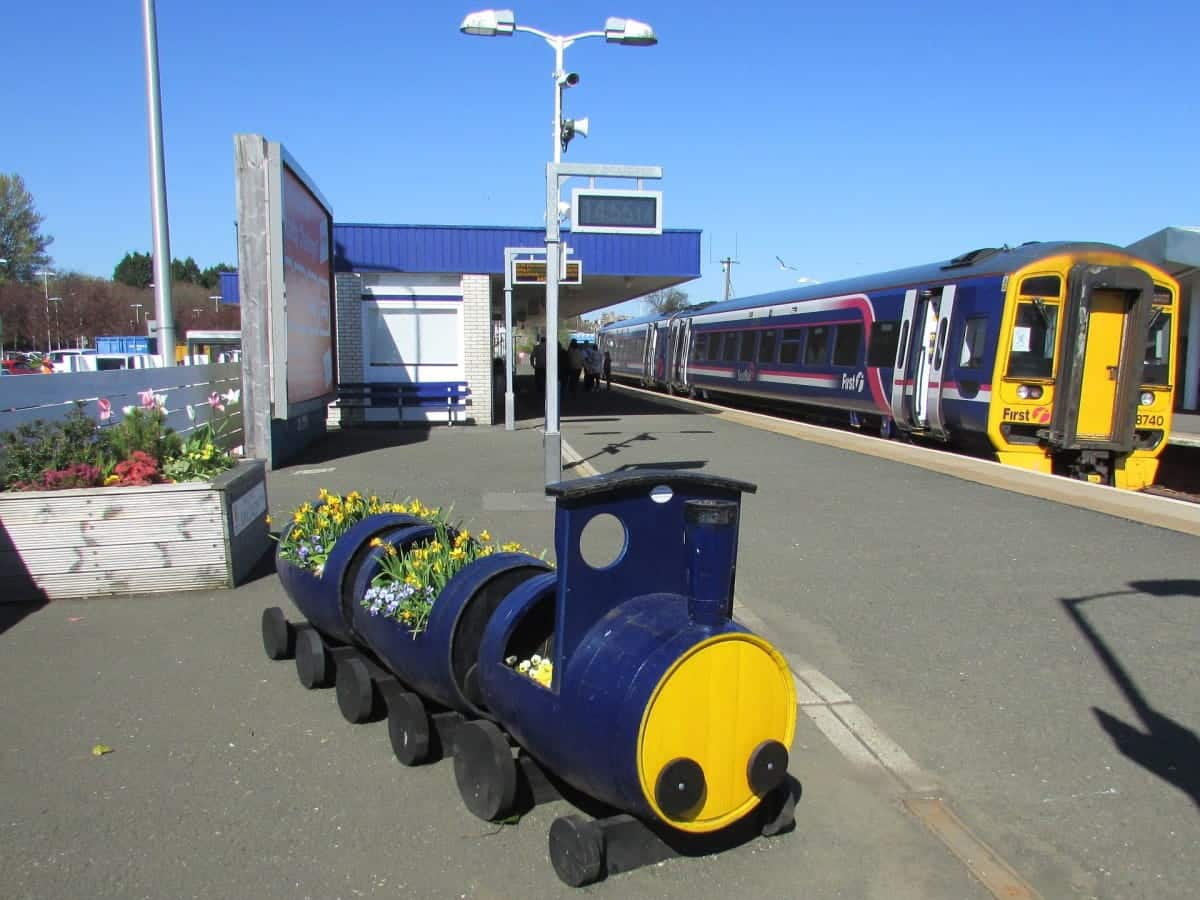
The south of Scotland is linked to the city by Glasgow Central Station, while Glasgow Queen Street Station has links to Edinburgh & North Scotland. The ScotRail website has information about all the available routes and timetables.
The SPT Roundabout ticket provides one-day unlimited travel by rail and subway to over 110 stations in the Greater Glasgow area. You can purchase these tickets through ScotRail or SPT Travel Centres. Please note that they are only valid after 09:00 Monday to Friday, all day at weekends, and Scottish public holidays. You can buy them either through ScotRail or SPT Travel Centres.
There are also dedicated rail services from London that whisk passengers in first-class luxury overnight to Glasgow, Edinburgh, Aberdeen and the Highlands. Caledonian Sleeper trains are easily one of the best options to travel in Scotland.
Frequently Asked Questions
What are the most popular attractions in Glasgow?
How do I get to Glasgow?
Glasgow Airport (address: Paisley, PA3 2SW) is a 15-minute bus ride from the city centre using the Glasgow Airport Express Bus service 500.
The other major airport is Glasgow Prestwick (address: Prestwick KA9 2PL) which is 32 miles from the city centre but has its own railway station that connects to Glasgow Central Station in 45 minutes.
How do I get around Glasgow?
There is an extensive bus network provided by First Bus and taxi’s can be hailed from virtually anywhere in the city centre. Additionally, the SPT Subway system runs in a circle around the main areas of Glasgow.
What is the weather like in Glasgow?
July and August are usually the hottest months with average temperatures of around 15°c.
January tends to be the coldest month with average temperatures of 3°c.
December and January suffer the worst of the wet weather with an average of 25 rainy days per month.
August has between 10 and 15 days of rain on average.
Protect Your Family From Scotland's Biting Midges
- Powerful, reliable protection for up to 8 hours
- Water- and sweat resistant
- Repels midges, mosquitoes, horse flies, sand flies, fleas and ticks
- Safe for use on adults, children over 30 months and pregnant women
- Non-sticky, moisturising with a pleasant fragrance
- Packaging may vary




